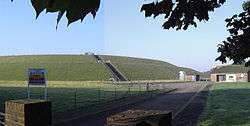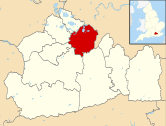Queen Elizabeth II Reservoir
The Queen Elizabeth II Reservoir lies to the south of the River Thames and to the west of the Island Barn Reservoir. To the north are the Bessborough and Knight reservoirs. The A3050 runs to the north of the reservoir and it is situated in Walton on Thames. It is managed by Thames Water.
| Queen Elizabeth II Reservoir | |
|---|---|
 Queen Elizabeth II Reservoir | |
| Location | Surrey |
| Coordinates | 51°23′27″N 0°23′32″W |
| Type | reservoir |
| Basin countries | United Kingdom |
| Surface area | 127.9 ha (316 acres) |
| Average depth | 15.3 m (50 ft) |
| Max. depth | 17.8 m (58 ft) |
| Water volume | 19.5 Gl (4.3×109 imp gal) |
History
The reservoir was authorised by the Metropolitan Water Board Act 1935 (25 & 26 Geo. 5. c. lxxxiv).[1] Excavation work on the reservoir started in 1936 under the supervision of the Board’s chief engineer Jonathan Davidson but was suspended upon the outbreak of war in 1939.[2] Work only recommenced in 1957 and was undertaken by W. & C. French.[3] The reservoir was completed in 1962 and was formally opened by the Queen on 30 March 1962.[4]
Construction
The reservoir embankment has a rolled clay core which extends down into the under-lying blue London clay.[5] The core wall is 3.6 m wide at the base and tapers above ground level to 3 m wide at the top of the wall. The clay was taken from three borrow pits.[5] On both sides of the core is a fill of mixed clay and gravel 0.9 m wide. The reservoir walls were constructed by dragging gravel from the floor of the reservoir but which was not compacted other than compaction by the construction machinery.[5] The top of the embankment is 15 m above ground level. Over the London clay is about 6 m of sandy gravel. A study in 2009 identified that about 750,000 tonnes of sand and gravel could be excavated from the bottom of the reservoir.[2]
The inlet and outlet valve towers are located at the north east and north west corners of the reservoir.
Ownership
The Metropolitan Water Board operated the reservoir until the Board was abolished in 1974 under the provisions of the Water Act 1973 (c. 37) ownership and control was transferred to the Thames Water Authority.[6] Under the provisions of the Water Act 1989 (c. 15) the Thames Water Authority was privatised as Thames Water.[7]
Environment
Bewick's swans have been spotted on this reservoir. In the winter of 1963 100,000 gulls were counted roosting at the reservoir.[9] As of 2020 Thames Water are reviewing the access arrangements for all three of the Walton reservoirs,[10] The design of the reservoir has an effect on the fish population that can live in the reservoir, the concrete shores means that only European perch and ruffe can breed, except for where there are empty fish cages constructed with netting, which support some plant growth and this allows small numbers of cyprinid fish to breed. The low numbers of fish in the reservoir have led to the zooplankton being dominated by large sized cladocerans and Daphnia and to high growth rates in the few fish that live there.[11] No fishing is permitted at the reservoir.[12]
Solar panels
In March 2016[13] Thames Water commissioned a farm of solar panels onto the reservoir which at the time was the world's largest floating solar farm. More than 23,000 panels[13] float on the reservoir generating 6.3 MW[14] of power (enough to power approximately 1,800 homes). The solar farm is expected to offset Thames Water's energy expenses used to power their nearby water treatment and pumping stations. The solar farm covers 1/10 of the reservoir's surface.[15]
See also
References
- https://www.legislation.gov.uk/changes/chron-tables/local/167
- "Walton Reservoirs". Engineering timelines. Retrieved 23 June 2020.
- "Queen Elizabeth II Reservoir". Pastscape. Retrieved 14 September 2015.
- The Times 31 March 1962
- Jackson, Donald C (ed) (1998). Dams. Routledge. ISBN 9780860787532.CS1 maint: extra text: authors list (link)
- "Water Act 1973". www.legislation.gov.uk. Retrieved 2020-06-23.
- https://www.legislation.gov.uk/ukpga/1989/15/contents/enacted
- A Guide to the Industrial Archaeology of the Borough of Elmbridge
- R.A.O. Hickling (1967). "The inland wintering of gulls in England, 1963". Bird Study. 14 (2): 104–113. doi:10.1080/0006365670947615.
- "Birdwatching". Thames Water. Retrieved 26 March 2020.
- Jan Kubečka & Anne Duncan (1994). "Low Fish Predation Pressure in the London Reservoirs: I. Species Composition, Density and Biomass". Internationale Revue der gesamten Hydrobiologie und Hydrographie. 79 (1): 143–155. doi:10.1002/iroh.19940790114.
- "Queen Elizabeth II Storage Reservoir". Allaboutangling.net Fishing in Berkshire, Buckinghamshire, Middlesex and Surrey. Retrieved 26 March 2020.
- Harvey, Fiona (2016-02-29). "World's biggest floating solar farm powers up outside London". The Guardian. ISSN 0261-3077. Retrieved 2017-05-30.
- "Queen Elizabeth Solar Farm Renewable energy scheme / Solar". www.renewables-map.co.uk. Retrieved 2017-05-30.
- "UK engineers building Europe's largest floating solar farm". The Engineer. Retrieved 2017-05-30.
